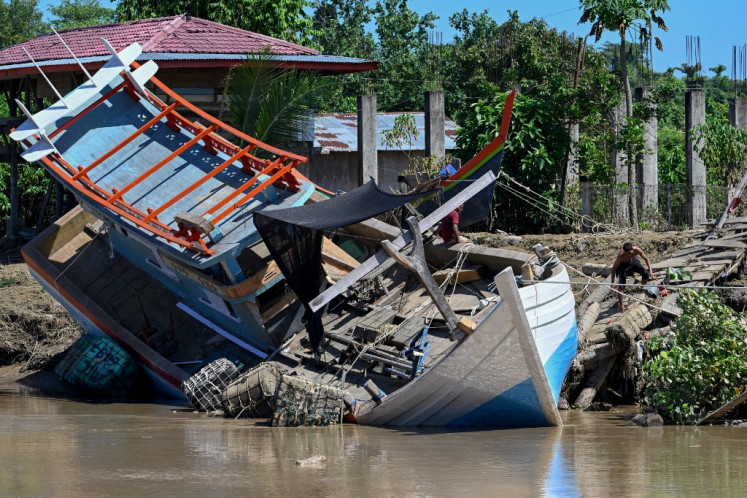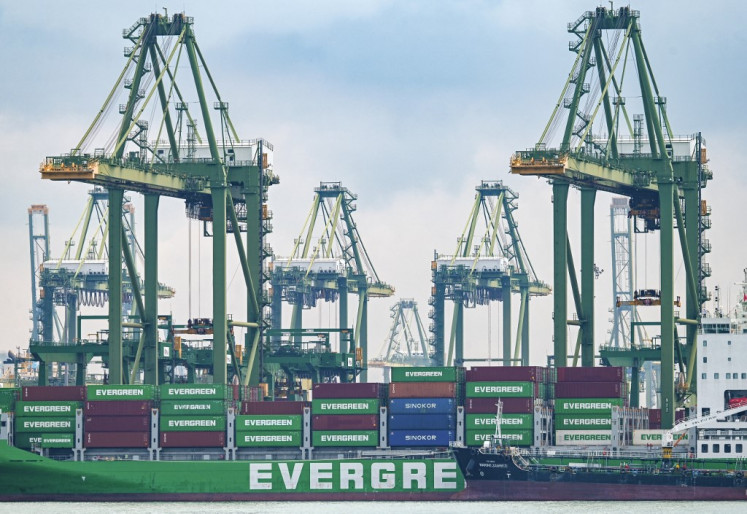Popular Reads
Top Results
Can't find what you're looking for?
View all search resultsPopular Reads
Top Results
Can't find what you're looking for?
View all search resultsGetting up close, and personal, with Kalimantan's river dolphin
Courtesy of YK RasHundreds of colorful houses, built on wooden poles, stand along the Mahakam River in East Kalimantan
Change text size
Gift Premium Articles
to Anyone
Courtesy of YK Ras
Hundreds of colorful houses, built on wooden poles, stand along the Mahakam River in East Kalimantan.
Some villages seem to consist solely of bridges, connecting the various houses to each other.
The Mahakam river delta is important not only for migrating birds and a number of endangered species, but also for the traditional Dayak, Kutai and Banjar people who all live along the river and live off its fish.
The river is also home to the rare Mahakam pesut ' a highly endangered freshwater dolphin species, which is slightly different from the Irrawaddy dolphins that are found in coastal areas in South and Southeast Asia.
Dutch researcher Danielle Kreb, who holds a PhD in research on the Irrawaddy dolphins, says she is conducting further research on the dolphin's specific DNA.
She did her first research on the dolphins back in 1997 but kept coming back before finally moving to Samarinda after meeting Budiono, the founder of the NGO Rare Aquatic Species of Indonesia (RASI) Conservation Foundation.
'The decision to engage with river dolphins has influenced my life greatly as we got married and now have one daughter. Now, I have two major reasons for staying in Indonesia,' Kreb said.
Budiono established the organization in 2000, with the aim of protecting aquatic dependent flora and fauna and eco systems and enhancing human livelihoods through sustainable resource use.
In 2012, he received the prestigious Whitley Award from the Whitley Fund for Nature.
Budiono said the biggest threats faced by the dolphins are gillnet entanglement, boat collisions and noise and chemical pollution.
A more recent threat, he added, was the conversion of swamp areas into oil palm plantations ' causing the dolphin habitat to decline and a decrease in local fish resources.
The organization focuses on community awareness and knowledge, but also works with local fishermen to engage them in sustainable forms of aqua-culture.
Some people in Kalimantan have also started the 'Save the Mahakam Dolphin' group, which now has over 5,000 members on Facebook, to raise awareness and organize trips to the river to spot the dolphin.
The Mahakam dolphin
'Many people still don't know about the dolphin, they just know the statue in Samarinda. They never see it and don't know that it's threatened. That's why these trips are useful, so people can see that it still exists and that it needs support,' said Innal Rahman, who is part of the RASI team and an active member who organizes trips to the river.
The sights along the Mahakam River are also a tourist attraction, as many bird species and the proboscis monkey, endemic to the island of Kalimantan, can be seen from the riverbanks.
'There are many fishing villages here that have not yet been discovered by tourists. People are warm here and you always feel welcome. We saw a lot of birds, fish, macaques and proboscis monkeys and, of course, the dolphins,' said Anna Poled áková, a Czech volunteer currently working for a bear sanctuary in Balikpapan who joined RASI in one of the trips on the Mahakam.
'I also became more familiar with the threats to the Irrawaddy dolphin than as an ordinary tourist. The good thing about RASI is that they are working with local people, which is the only way to successfully conserve any wild species, in my opinion.'
On the trip, Budiono and his team talk to the locals and discuss the issues that they are facing.
RASI has also been conducting bi-annual population monitoring of the dolphin, mapping its core areas and consulting about certain protected areas with the villagers.
The efforts are vital since once the area is converted to oil palm plantations, it will lose its natural functions.
'There are no buffer zones between coal mining and palm oil and the natural wetlands of the villages. Villagers have to deal with bad water quality and have skin diseases after companies become active in their areas. Some villagers even have to leave their villages to find a healthier environment,' Budiono said.
On the last trip RASI made to the Mahakam, villagers in three subdistricts ' Muara Muntai, Kota Bangun and Muara Kaman ' agreed on the boundaries and regulations of the proposed protected area of 51,000 hectares, which also includes important fish spawning areas.
'We can only raise the alarm with the government but the actual work that should be done in the future is to re-examine permits and impose sanctions or closure on companies that are causing environmental damage to areas outside of their permit areas.'
Save the Mahakam group - Courtesy of Innal Rahman
Free time: School students play around after school around the houses alongside the Mahakam River. JP/Emke de Vries
' The writer is an intern at The Jakarta Post.
_____________________
For more information please visit the website: www.ykrasi.org or facebook page/group: Rare Aquatic Species of Indonesia. or just email: yk.rasi@gmail.com














